| Listing 1 - 10 of 17 | << page >> |
Sort by
|
Book
Year: 2010 Publisher: Washington, D.C. : The Urban Institute : [USDA Economic Research Service],
Abstract | Keywords | Export | Availability | Bookmark
 Loading...
Loading...Choose an application
- Reference Manager
- EndNote
- RefWorks (Direct export to RefWorks)
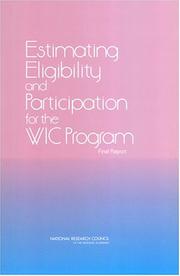
ISBN: 1280179600 9786610179602 0309525519 9780309525510 9781280179600 9780309089623 030908962X 0309166977 Year: 2003 Publisher: Washington, D.C. : National Academies Press,
Abstract | Keywords | Export | Availability | Bookmark
 Loading...
Loading...Choose an application
- Reference Manager
- EndNote
- RefWorks (Direct export to RefWorks)
Food relief --- Statistical methods. --- Evaluation. --- Special Supplemental Nutrition Program for Women, Infants, and Children (U.S.) --- Famine relief --- Food aid programs --- Food assistance programs --- Special Supplemental Program for Women, Infants, and Children (U.S.) --- United States. --- WIC Program (U.S.) --- Disaster relief --- Humanitarian assistance --- Public welfare --- Emergency food supply --- Special Supplemental Food Program for Women, Infants, and Children (U.S.) --- Food distribution programs
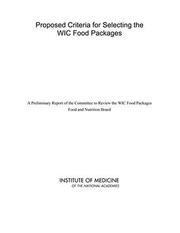
ISBN: 0309567769 9780309567763 0309092981 9780309092982 0309182247 Year: 2004 Publisher: Washington, D.C. : National Academy Press,
Abstract | Keywords | Export | Availability | Bookmark
 Loading...
Loading...Choose an application
- Reference Manager
- EndNote
- RefWorks (Direct export to RefWorks)
Food relief --- Special Supplemental Food Program for Women, Infants, and Children (U.S.) --- United States. --- WIC Program (U.S.) --- Special Supplemental Food Program for Women, Infants, and Children --- W.I.C. Program (U.S.) --- Special Supplemental Food Program for Women, Infants & Children --- Special Supplemental Nutrition Program for Women, Infants, and Children (U.S.)
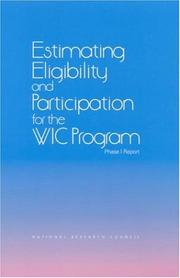
ISBN: 0309075904 0309510767 9780309510769 9780309075909 0305075904 0309170656 9780309170659 Year: 2001 Publisher: Washington, DC : National Academy Press,
Abstract | Keywords | Export | Availability | Bookmark
 Loading...
Loading...Choose an application
- Reference Manager
- EndNote
- RefWorks (Direct export to RefWorks)
Food relief --- Social Welfare & Social Work - General --- Social Welfare & Social Work --- Social Sciences --- Statistical methods --- Evaluation --- Statistical methods. --- Evaluation. --- Special Supplemental Nutrition Program for Women, Infants, and Children (U.S.) --- Famine relief --- Food aid programs --- Food assistance programs --- Special Supplemental Program for Women, Infants, and Children (U.S.) --- United States. --- WIC Program (U.S.) --- Disaster relief --- Humanitarian assistance --- Public welfare --- Emergency food supply --- Special Supplemental Food Program for Women, Infants, and Children (U.S.) --- Food distribution programs
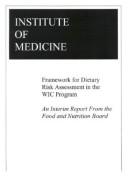
ISBN: 0309072638 9786610185245 1280185244 0309564956 9780309564953 9780309072632 0309183731 Year: 2000 Publisher: Washington, D.C. : National Academy Press,
Abstract | Keywords | Export | Availability | Bookmark
 Loading...
Loading...Choose an application
- Reference Manager
- EndNote
- RefWorks (Direct export to RefWorks)
Malnutrition in pregnancy --- Malnutrition in children --- Malnutrition in infants --- Prevention. --- Special Supplemental Food Program for Women, Infants, and Children (U.S.) --- Special Supplemental Nutrition Program for Women, Infants, and Children (U.S.) --- Special Supplemental Program for Women, Infants, and Children (U.S.) --- United States. --- WIC Program (U.S.) --- Special Supplemental Food Program for Women, Infants, and Children --- W.I.C. Program (U.S.) --- Special Supplemental Food Program for Women, Infants & Children --- Nutrition disorders in infants
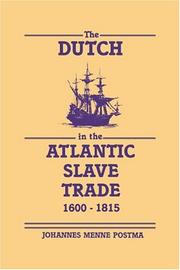
ISBN: 0521365856 0521048249 0511528957 0511830122 9780521365857 9780511528958 9780521048248 Year: 1990 Publisher: Cambridge : Cambridge university press,
Abstract | Keywords | Export | Availability | Bookmark
 Loading...
Loading...Choose an application
- Reference Manager
- EndNote
- RefWorks (Direct export to RefWorks)
Presenting a thorough analysis of the Dutch participation in the transatlantic slave trade, this book is based upon extensive research in Dutch archives. The book examines the whole range of Dutch involvement in the Atlantic slave trade from the beginning of the 1600s to the nineteenth century.
Slave trade --- Slavery --- Esclaves --- Esclavage --- History --- Commerce --- Histoire --- West-Indische Compagnie (Netherlands) --- West-Indische Compagnie (Pays-Bas) --- Slave-trade --- History. --- 326.1 --- -Slavery --- -326.1 --- -Abolition of slavery --- Antislavery --- Enslavement --- Mui tsai --- Ownership of slaves --- Servitude --- Slave keeping --- Slave system --- Slaveholding --- Thralldom --- Crimes against humanity --- Serfdom --- Slaveholders --- Slaves --- Slavenhandel --- Netherlands --- -West-Indische Compagnie (Netherlands) --- Generale Geoctroyeerde Nederlandsche West-Indische Compagnie --- Geoctroyeerde Nederlandsche West-Indische Compagnie --- Vereenigde Nederlandsche West-Indische Compagnie --- Dutch West India Company --- West India Company (Netherlands) --- Nederlandsche West-Indische Compagnie. --- Nederlantse West-Indische Compagnie --- WIC --- West-Indy Company (Netherlands) --- Westindische Compagnie (Netherlands) --- -Slavenhandel --- -326.1 Slavenhandel --- Abolition of slavery --- 326.1 Slavenhandel --- West-Indische Compagnie --- Africa [West ] --- Latin America --- Arts and Humanities --- Slave-trade - Netherlands - History. --- Slave-trade - Africa, West - History. --- Slavery - Latin America - History. --- 15.70 history of Europe. --- Netherlands. --- Slave-trade, Africa, West, History. --- Slave-trade, Netherlands, History. --- Slavenhandel. --- Slavery, Latin America, History. --- West Africa. --- West-Indische Compagnie. --- slave trade. --- Nederland. --- Niederlande. --- Verenigd Koninkrijk der Nederlanden.
Book
ISBN: 3631807627 3631807635 3631802013 Year: 2020 Publisher: Bern Peter Lang International Academic Publishing Group
Abstract | Keywords | Export | Availability | Bookmark
 Loading...
Loading...Choose an application
- Reference Manager
- EndNote
- RefWorks (Direct export to RefWorks)
The book discusses the sociolinguistic status and prestige of the Polish language and the changes in the national identity of Catholics in Belarus due to the switch from Polish to Belarusian in the Catholic Church. The research shows that the national identification of Catholics in Belarus is changing. The oldest generations most often self-identify as Polish. For those from the middle and youngest generations, the link between nationality and their religion is not obvious as being a Catholic does not exclude a Belarusian self-identity. Belonging to the Catholic Church results from being baptized in the Catholic rite, while national identity can be defined in many ways and re-defined by various life experiences. Catholicism has proven to be a less debated and more durable category than nationality.
Language question in the church --- Catholic Church --- Liturgy. --- Church --- Language and languages --- Religious aspects --- Christianity --- Church of Rome --- Roman Catholic Church --- Katholische Kirche --- Katolyt︠s︡ʹka t︠s︡erkva --- Römisch-Katholische Kirche --- Römische Kirche --- Ecclesia Catholica --- Eglise catholique --- Eglise catholique-romaine --- Katolicheskai︠a︡ t︠s︡erkovʹ --- Chiesa cattolica --- Iglesia Católica --- Kościół Katolicki --- Katolicki Kościół --- Kościół Rzymskokatolicki --- Nihon Katorikku Kyōkai --- Katholikē Ekklēsia --- Gereja Katolik --- Kenesiyah ha-Ḳatolit --- Kanisa Katoliki --- כנסיה הקתולית --- כנסייה הקתולית --- 가톨릭교 --- 천주교 --- Agade --- Belarus --- Białorusi --- Boga? --- Catholic church in Belarus --- Catholics --- Centuries --- Conversations --- Early --- Golachowska --- katolików --- language of religion --- Late --- mówić --- Multilingualism --- national identification --- Pana --- Polish in Belarus --- przełomie --- Sociolinguistic --- sociolinguistics --- study --- Twentieth --- Twenty --- wieku --- wielojęzyczność --- Wydawnictwo
Book
Year: 2020 Publisher: Basel, Switzerland MDPI - Multidisciplinary Digital Publishing Institute
Abstract | Keywords | Export | Availability | Bookmark
 Loading...
Loading...Choose an application
- Reference Manager
- EndNote
- RefWorks (Direct export to RefWorks)
Food insecurity and low resources continue to be a burden influencing the health, well-being, growth, and development of millions of U.S. children and adults. Groups and individuals experiencing restrained access to food are our neighbors, individuals we may see each day, and individuals who we may not interact with or see because of their isolated situations. They include the elderly, those experiencing mental illness, veterans, certain race/ethnic groups, adolescents, young women with children, those living in rural areas, and those using food pantries, among others. Many of these groups, both hidden and visible, have rates of food insecurity above the national average that are resistant to national improvements in food security. Yet, attention to these subsets of the population is imperative to improve U.S. health and nutrition and to reduce rates of chronic disease. Many groups face specific barriers to maintaining sufficient food, for example, rural populations may find it difficult to access federal food assistance or other resources such as food pantries and nutrition education because of distance or lack of consistent internet access separating them from these resources. Further, their remote locations may make it difficult to obtain the types of foods that they prefer. Other specific barriers may include limited facilities and equipment for food preparation, access to culturally appropriate foods and preparation supplies, and foods that complement the foods that they already have. Tailored approaches to quantify access to food, the nutrition environment, dietary intake, and other barriers are necessary to build successful interventions and to quantify the needs of these populations.
Research & information: general --- Biology, life sciences --- Food & society --- NHANES --- dietary supplement --- micronutrients --- DRI --- food security --- food group intake --- child food security --- popularly consumed foods --- low-resource children --- adolescents --- food intake --- beverage intake --- dietary intake --- food insecurity --- US children --- allostatic load --- biological risk --- chronic stress --- National Health and Nutrition Examination Surveys --- covid-19 --- low-income adults --- disparities --- survey --- incentive programs --- Supplemental Nutrition Assistance Program (SNAP) --- fruits and vegetables --- low-income --- farmers’ markets --- dietary quality --- produce intake --- produce purchasing --- food access --- executive function --- preschool children --- community food environment --- infants --- minority --- diet diversity --- diet quality --- food resource management --- self-confidence --- nutrition education --- financial practices --- SNAP-Ed --- Head Start --- young children --- child obesity --- Guam --- Children’s Healthy Living (CHL) --- islander --- Pacific --- Micronesia --- supplemental nutrition assistance program-education --- food assistance --- SNAP --- food stamps --- WIC --- food pantry --- emergency food programs --- low resource --- nutrition --- diet --- health --- food environment --- interventions --- U.S. population
Book
Year: 2020 Publisher: Basel, Switzerland MDPI - Multidisciplinary Digital Publishing Institute
Abstract | Keywords | Export | Availability | Bookmark
 Loading...
Loading...Choose an application
- Reference Manager
- EndNote
- RefWorks (Direct export to RefWorks)
Food insecurity and low resources continue to be a burden influencing the health, well-being, growth, and development of millions of U.S. children and adults. Groups and individuals experiencing restrained access to food are our neighbors, individuals we may see each day, and individuals who we may not interact with or see because of their isolated situations. They include the elderly, those experiencing mental illness, veterans, certain race/ethnic groups, adolescents, young women with children, those living in rural areas, and those using food pantries, among others. Many of these groups, both hidden and visible, have rates of food insecurity above the national average that are resistant to national improvements in food security. Yet, attention to these subsets of the population is imperative to improve U.S. health and nutrition and to reduce rates of chronic disease. Many groups face specific barriers to maintaining sufficient food, for example, rural populations may find it difficult to access federal food assistance or other resources such as food pantries and nutrition education because of distance or lack of consistent internet access separating them from these resources. Further, their remote locations may make it difficult to obtain the types of foods that they prefer. Other specific barriers may include limited facilities and equipment for food preparation, access to culturally appropriate foods and preparation supplies, and foods that complement the foods that they already have. Tailored approaches to quantify access to food, the nutrition environment, dietary intake, and other barriers are necessary to build successful interventions and to quantify the needs of these populations.
NHANES --- dietary supplement --- micronutrients --- DRI --- food security --- food group intake --- child food security --- popularly consumed foods --- low-resource children --- adolescents --- food intake --- beverage intake --- dietary intake --- food insecurity --- US children --- allostatic load --- biological risk --- chronic stress --- National Health and Nutrition Examination Surveys --- covid-19 --- low-income adults --- disparities --- survey --- incentive programs --- Supplemental Nutrition Assistance Program (SNAP) --- fruits and vegetables --- low-income --- farmers’ markets --- dietary quality --- produce intake --- produce purchasing --- food access --- executive function --- preschool children --- community food environment --- infants --- minority --- diet diversity --- diet quality --- food resource management --- self-confidence --- nutrition education --- financial practices --- SNAP-Ed --- Head Start --- young children --- child obesity --- Guam --- Children’s Healthy Living (CHL) --- islander --- Pacific --- Micronesia --- supplemental nutrition assistance program-education --- food assistance --- SNAP --- food stamps --- WIC --- food pantry --- emergency food programs --- low resource --- nutrition --- diet --- health --- food environment --- interventions --- U.S. population
Book
Year: 2020 Publisher: Basel, Switzerland MDPI - Multidisciplinary Digital Publishing Institute
Abstract | Keywords | Export | Availability | Bookmark
 Loading...
Loading...Choose an application
- Reference Manager
- EndNote
- RefWorks (Direct export to RefWorks)
Food insecurity and low resources continue to be a burden influencing the health, well-being, growth, and development of millions of U.S. children and adults. Groups and individuals experiencing restrained access to food are our neighbors, individuals we may see each day, and individuals who we may not interact with or see because of their isolated situations. They include the elderly, those experiencing mental illness, veterans, certain race/ethnic groups, adolescents, young women with children, those living in rural areas, and those using food pantries, among others. Many of these groups, both hidden and visible, have rates of food insecurity above the national average that are resistant to national improvements in food security. Yet, attention to these subsets of the population is imperative to improve U.S. health and nutrition and to reduce rates of chronic disease. Many groups face specific barriers to maintaining sufficient food, for example, rural populations may find it difficult to access federal food assistance or other resources such as food pantries and nutrition education because of distance or lack of consistent internet access separating them from these resources. Further, their remote locations may make it difficult to obtain the types of foods that they prefer. Other specific barriers may include limited facilities and equipment for food preparation, access to culturally appropriate foods and preparation supplies, and foods that complement the foods that they already have. Tailored approaches to quantify access to food, the nutrition environment, dietary intake, and other barriers are necessary to build successful interventions and to quantify the needs of these populations.
Research & information: general --- Biology, life sciences --- Food & society --- NHANES --- dietary supplement --- micronutrients --- DRI --- food security --- food group intake --- child food security --- popularly consumed foods --- low-resource children --- adolescents --- food intake --- beverage intake --- dietary intake --- food insecurity --- US children --- allostatic load --- biological risk --- chronic stress --- National Health and Nutrition Examination Surveys --- covid-19 --- low-income adults --- disparities --- survey --- incentive programs --- Supplemental Nutrition Assistance Program (SNAP) --- fruits and vegetables --- low-income --- farmers’ markets --- dietary quality --- produce intake --- produce purchasing --- food access --- executive function --- preschool children --- community food environment --- infants --- minority --- diet diversity --- diet quality --- food resource management --- self-confidence --- nutrition education --- financial practices --- SNAP-Ed --- Head Start --- young children --- child obesity --- Guam --- Children’s Healthy Living (CHL) --- islander --- Pacific --- Micronesia --- supplemental nutrition assistance program-education --- food assistance --- SNAP --- food stamps --- WIC --- food pantry --- emergency food programs --- low resource --- nutrition --- diet --- health --- food environment --- interventions --- U.S. population
| Listing 1 - 10 of 17 | << page >> |
Sort by
|

 Search
Search Feedback
Feedback About UniCat
About UniCat  Help
Help News
News